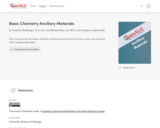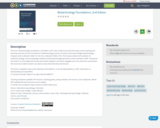
Tool to help apply the population-focused nursing process used in community health nursing.
- Subject:
- Nursing
- Material Type:
- Activity/Lab
- Author:
- Christy Gipson
- Date Added:
- 01/04/2022

Tool to help apply the population-focused nursing process used in community health nursing.

This resource contains a student activity handout, a facilitation guide, example solutions, and class notes. Students work together to discover one-to-one correspondences between various infinite sets of numbers and the set of natural numbers. At the end of this activity the compiled results of their group work form a list of infinite sets that all have the same cardinality as the set of natural numbers. Instructors may take this lesson further by discussion countably infinite versus uncountably infinite sets. This activity aligns with MATH 1332 Learning Outcome 1: Apply the language and notation of sets.

This simulation gives students the opportunity to explore both area and perimeter of 2-dimensional shapes. Students can explore by creating shapes and having the sim calculate the area and perimeter. They can also play a game where the goal is to create a shape with a specified area or area and perimeter, or to calculate the area and/or perimeter of a given shape.

This activity explores what it means for a computer to be intelligent and introduces the topic of what a computer program is and how everything computers do simply involves following instructions written by (creative) computer programmers. Learners interact with a piece of paper that contains rules for playing a perfect game of noughts-and-crosses (tic-tac-toe). The activity contains some thought provoking (and humorous) discussion questions. Explanation, variations, extensions, and resources are included in the PDF.

This lab book is written to accompany an introductory astronomy course.

These activities were written by students in the ASURE Immune Response and Behavior Lab at Indiana University Bloomington. Each “chapter” shows an activity designed to introduce kids to a biology-related topic, which can be taught and led by their parents all with common household items. We hope that they’re helpful and fun for you to complete with your kids!
![Audience and Purpose [Lesson]](https://img.oercommons.org/160x134/thecb-production/media/screenshots/156c268e0f57b447775cd73bea9451cd4a156fc06b0aa59dcfa1224b6984fad0.png)
Upon successful completion of this lesson, students will
- Identify an audience and tone for your writing as well as explain why identifying these components are important.
- Utilize the RAFT writing strategy to plan an appropriate style according to audience and purpose.
Author: Brandi Morley
Editor: Mary Landry, C. Anneke Snyder
Supervisor: Terri Pantuso

With this graphic organizer, students gain practice identifying devices relevant to literary texts and reasoning through how these devices support the author’s purpose.
Author: Frances Santos
Editor: Mary Landry, C. Anneke Snyder
Supervisor: Terri Pantuso

Lab Manual for General Biology I

This is a OER lab manual for BIOL 1108 developed by HCC faculty. This manual is in alignments with the curriculum requirements for Biology Non Science Majors lab.

These recitation, lab, and chapter worksheet ancillary materials for basic chemistry courses were developed under a Round 13 Mini-Grant.

This resource contains a rubric, an activity handout, a facilitation guide, and tex files. The material is meant to be used for those teaching a college algebra course. The activities are meant to provide a deeper understanding (than a traditional course offers) of some of the topics covered in a college algebra course. The activities are intended for group activities and options exist for use in a single class or multiple classes.

The multi-lesson "Best Class/Worst Class" project provides a way for students and professor to set expectations for course performance collaboratively, while simultaneously modeling productive online interaction strategies. Students become more aware of their own learning process and the processes of those with whom they will be working, creating necessary bridges to successful collaboration. In addition, students are able to develop practical skills in navigating the online environment before being tasked with heavily-weighted course components.This project is designed to be implemented alongside discipline-specific course content.

By the end of this activity, students will be able to demonstrate their understanding of the First, Second, and Third Amendments of the Bill of Rights by completing a cloze exercise, using context clues and prior knowledge to fill in key terms without referencing their notes.
Author: Sharon Haigler
Editor: Mary Landry, C. Anneke Snyder
Supervisor: Terri Pantuso

Lab Manual for BIO101 at Mt Hood Community College. The associated textbook is available at https://openoregon.pressbooks.pub/mhccbiology101/

This material is labwork meant to be used in conjunction with the Candela "Biology II" course.

This set of Biology I lab assignments ensures students have the opportunity to apply the concepts and information they learn as they work through Biology I course content. Content includes lab assignments for students, as well as Instructor Materials Preparation for each lab with detailed lists of what faculty members need for each lab. The materials required are broken down by student (or groups of students). These lab materials were developed by faculty at College of the Redwoods and Tidewater Community College.

Assorted biology-related OER including biomedical science, biology and forensic science. OER in multiple formats including video, animations and downloadable text.

This course presents a design philosophy and a design approach, dedicated to rehabilitation technology. This field was selected because of human-machine interaction is inherent and vital. Illustrative examples will be discussed by their entire design process

Biotechnology Foundations, 2nd Edition, 2019, was created to provide free open-access teaching and learning resources for two Introduction to Biotechnology courses at Austin Community College, Biotechnology Program (Intro to Biotech I BIOL1414 & Intro to Biotech II BIOL1415). This book provides the foundation of chemistry, biology, and microbiology needed to build biotechnology laboratory science workforce skills. The goal of this book is to encourage both faculty and student adoption and active, engaged use in the classroom and provide the resources students need to succeed as entry-level laboratory technicians.